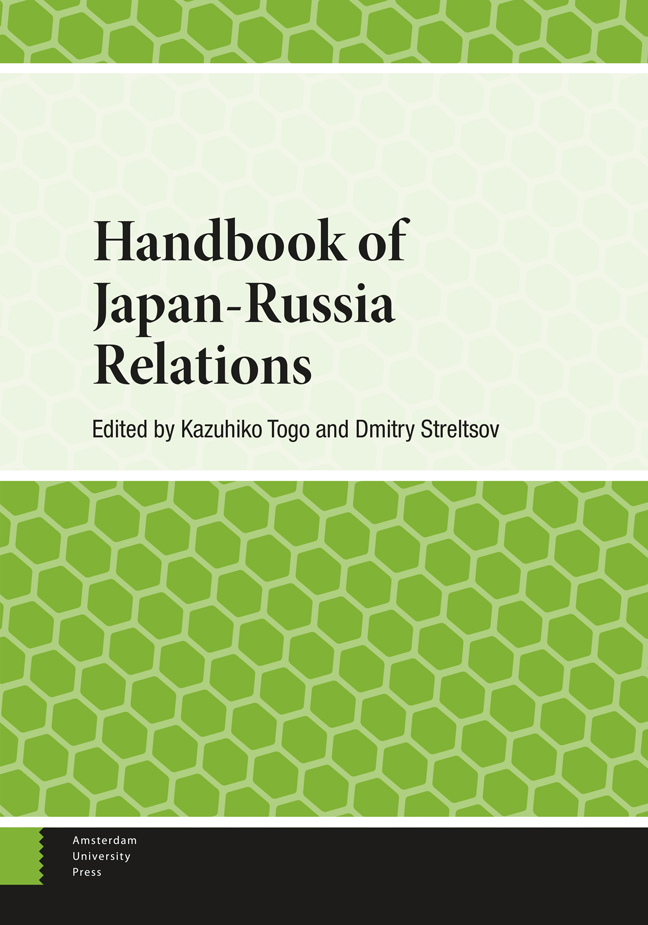Book contents
- Frontmatter
- Contents
- Dedication
- Acknowledgements
- Contributors
- Abbreviations
- Introduction
- Part 1 War and Peace: Diplomatic Relations and Security
- Part 2 Territory
- Part 3 The Economy and Energy
- Part 4 Disaster Cooperation
- Part 5 Culture
- Part 6 Perceptions of the Other
- Appendix 1 1956 Joint Declaration
- Appendix 2 Tokyo Declaration (1993)
- Appendix 3 Moscow Declaration (1998)
- Appendix 4 Irkutsk Statement (2001)
- Appendix 5 Foreign Ministry Statement (2022)
- Index
6 - The Japanese View of Northern Territorial Questions, or NTQ
Published online by Cambridge University Press: 26 March 2024
- Frontmatter
- Contents
- Dedication
- Acknowledgements
- Contributors
- Abbreviations
- Introduction
- Part 1 War and Peace: Diplomatic Relations and Security
- Part 2 Territory
- Part 3 The Economy and Energy
- Part 4 Disaster Cooperation
- Part 5 Culture
- Part 6 Perceptions of the Other
- Appendix 1 1956 Joint Declaration
- Appendix 2 Tokyo Declaration (1993)
- Appendix 3 Moscow Declaration (1998)
- Appendix 4 Irkutsk Statement (2001)
- Appendix 5 Foreign Ministry Statement (2022)
- Index
Summary
It is not always easy to be a neighbor to the Russians. For almost three centuries of bilateral relations, Japan has had to cope with this challenge of encounters by various parameters, including the territorial question, its demarcation and interconnection. After World War II and the San Francisco treaty of 1951, the ownership of the Kurile archipelago and what is called the “Northern Territorial Questions” remained the most serious issues between the two capitals when both began talks on the peace treaty from 1955. The historic agreement of the 1956 Declaration, Prime Minister Tanaka’s 1973 visit and the perestroika movement of 1985–1991, eventually failed to solve the issue. Even after the demise of the Soviet Union, Japanese administrations tried, eventually culminating in Prime Minister Abe Shinzō’s 27 meetings with President Putin, but failed by 2020.
Introduction
Since the 18th century when the Bering Strait was determined as the demarcation line between the Eurasian and American continents, the geopolitics of the North Pacific region became the focus of a new frontier of “globalization” of that time. It became inevitable that the governments of both the Russian Empire and Tokugawa Japan would begin to keep an eye on each other, though their contacts were rare and sporadic. Russian moves to the Eurasian Far East, and eventually even to North America, worried Tokugawa Japan, partly because there were few direct relations from the 17th century. Interest in and eventual explorations of the Kurile Archipelago were taken by various European powers around 1800.
Among others, the Russian expedition into the Far East was activated in the form of the Russian-American Company for the development and commercial interests of these regions. However, the activities of this company were noticed by the Japanese side and alarmist voices were raised by the end of the 18th century, particularly from intellectuals and the ruling samurai of the northern part of Japan, as well as the Tokugawa Shogunate. A medical doctor from Northern Japan, Kudō Heisuke wrote a famous pamphlet on the threat of “Red Ezo” (Russians) in 1781.
This was followed by the expedition of Russians who asked for the opening of trade and diplomacy with Tokugawa Japan. Adam Laxman, a lieutenant, came to Nemuro in 1792, to promote a trade relationship with the Matsumae clan that governed the Hokkaido region at that time, as is pervasively argued by Professor Michiko Ikuta.
- Type
- Chapter
- Information
- Handbook of Japan-Russia Relations , pp. 95 - 114Publisher: Amsterdam University PressPrint publication year: 2024



